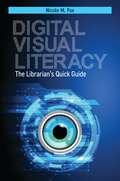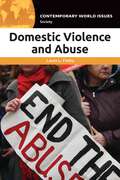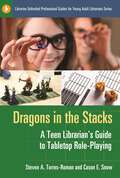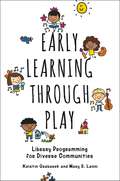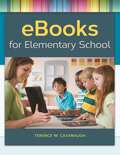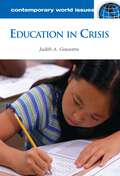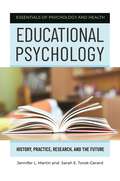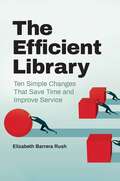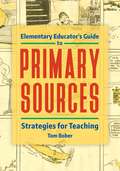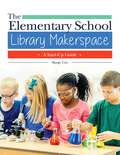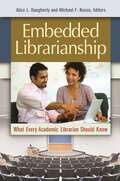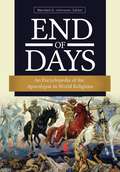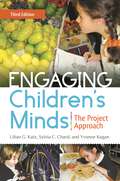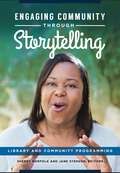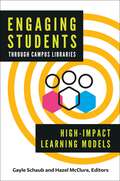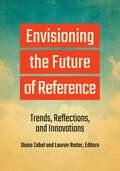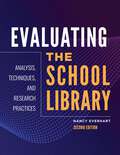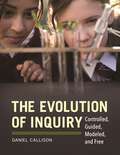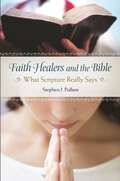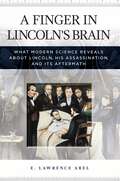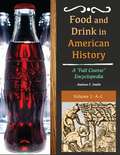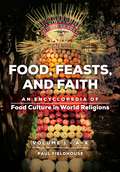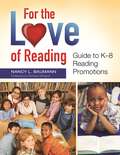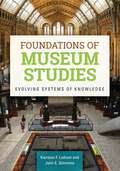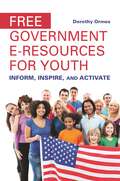- Table View
- List View
Digital Visual Literacy: The Librarian's Quick Guide
by Nicole M. FoxDesigned to introduce visual literacy to instructional librarians, this book shows librarians how to make visual literacy relevant and engaging by framing it as a digital skill.Millions of images are uploaded to social media every day, and students are increasingly being asked to participate in such image-rich research projects as websites and blogs. Image manipulation and photo editing are commonplace, but the visual literacy skills needed to detect that kind of misinformation aren't.Students need help learning how to find, evaluate, and use images in an ethical and effective manner. Digital Visual Literacy is designed to introduce visual literacy to instructional librarians. This concise introduction teaches visual literacy as a digital skill, complete with digital humanities-based workshops and assignments to make instruction informative and engaging. It covers all aspects of visual literacy, from copyright to image evaluation. Each chapter clearly explains visual literacy standards and proficiencies and offers practical instructional assignments, in-class demonstrations, and more through the use of digital humanities tools.
Domestic Violence and Abuse: A Reference Handbook (Contemporary World Issues)
by Laura L. FinleyA comprehensive and timely resource for students, activists, educators, and advocates, Domestic Violence and Abuse: A Reference Handbook provides a rich and scholarly assessment of this important social issue while also including stories and profiles for a more personal understanding.Domestic Violence and Abuse: A Reference Handbook provides a thorough review of the most recent research about intimate partner violence. Additionally, a historical review provides readers with a sense of how views on domestic violence have changed over time and how different policies and practices have and have not been successful. Appropriate for readers at the high school level and above, the volume focuses on the scope, extent, and characteristics of domestic violence and offers several unique elements, including profiles of significant individuals, personal stories from advocates, activists and survivors, and a review of controversial issues. The volume also includes a chronology of key events, relevant data and documents, primary source data, and recommended resources.
Dragons in the Stacks: A Teen Librarian's Guide to Tabletop Role-Playing (Libraries Unlimited Professional Guides for Young Adult Librarians Series)
by Steven A. Torres-Roman Cason E. SnowA one-stop, complete guide to tabletop role-playing games for novice librarians as well as seasoned players.Tabletop role-playing games (RPGs) are a perfect fit for library teen services. They not only hold great appeal for teen patrons, but also help build important skills ranging from math and literacy to leadership and dramatics. Role-playing games are cost-effective too. Dragons in the Stacks explains why RPGs are so effective at holding teenagers' attention, identifies their specific benefits, outlines how to select and maintain a RPG collection, and demonstrates how they can enhance teen services and be used in teen programs. Detailed reviews of role-playing games are included as well, with pointers on their strengths, weaknesses, and library applications. Coauthored by an experienced young adult librarian and an adult services librarian, this is the definitive guide to RPGs in the library, and the only one currently available.
Early Learning through Play: Library Programming for Diverse Communities
by Kristin Grabarek Mary R. LanniThis creative guidebook teaches librarians in diverse communities how to develop and implement early learning programming beyond traditional storytimes.While traditional library storytimes are excellent tools for families, equally important is play. Children learn through play in many ways; it stimulates exploration and curiosity and builds gross and fine motor skills that are critical to reading and writing success. Perhaps most importantly, play has the power to cross barriers of culture and language, allowing families from differing backgrounds to learn together.In this book, Kristin Grabarek and Mary R. Lanni—the pioneers of Little University, an early learning program that focuses on play-based learning—share their experiences and provide guidance for implementing similar programs at libraries of various sizes and budgets. They teach readers how to create programs for a diverse group of families, work with outside providers, choose supplies, estimate costs, market your programming, and overcome the challenges of both big and small budgets and many or few patrons. These practical plans will enhance storytimes and even help build a brand-new early learning program.
eBooks for Elementary School
by Terence W. CavanaugheBooks offer students as well as teachers, school and public librarians, and parents tremendous possibilities. This book explains how to expand and enhance the reading experience through the use of technology.Today, eBooks are everywhere, and the use of digital learning materials is beginning to supplant traditional printed materials. As the world shifts to digital books, both teachers and students need to be comfortable and effective using materials in this format. This book helps you to apply eBook materials to existing curricula to create interactive educational activities and have access to more materials to support reading instruction, literacy, standards, and reading in the content areas. Author Terence W. Cavanaugh, an expert on teaching with technology, describes numerous strategies for integrating eBooks into reading instruction and remediation for students in preschool through grade 6. He covers the hardware and software used, the wide range of formats available, and research conducted on the use of eBooks with students as well as how to access free resources such as digital libraries and special collections that make eBooks available for schools. The book also contains a chapter dedicated to using eBooks to help emergent or struggling readers.
Education in Crisis: A Reference Handbook (Contemporary World Issues)
by Judith A. GouwensA description and critique of education reform in the United States since the 1950s, focusing on the current condition of American schools and efforts to increase both educational opportunity and overall excellence.Authoritative and objective, Education in Crisis: A Reference Handbook is a critical look at the current state of the American school system, the conditions that have led many to label it "in crisis," and solutions aimed at leveling the educational playing field, elevating overall student achievement, and keeping American students competitive on the world stage.Education in Crisis shows how competing economic, political, philosophical, psychological, and global interests have influenced American education reform. It then covers a range of reform initiatives, including magnet schools, basic skills curriculum, home schooling, and the role of technology. A comparison of the U.S. education system to those of other countries and a presentation of helpful resources round out this essential volume for educators, policymakers, parents, and anyone concerned about the nation's schools.
Educational Psychology: History, Practice, Research, and the Future (Essentials of Psychology and Health)
by Jennifer L. Martin Sarah E. Torok-GerardA comprehensive introduction to educational psychology, this volume is inclusive of all of the essentials—covering history, profiles, theories, applications, research, case studies, current events, issues, controversies, and more.Focused on human learning and teaching, the field of educational psychology informs a range of educational challenges, including instructional design, curriculum development, organizational learning, special education, student motivation, and classroom management. In this book, two veteran professors in the fields of education and psychology, offer a clear and concise yet comprehensive overview of this growing specialty. This volume will be valuable not only to university students aiming to understand psychology's subfields and to choose a major or a specialty, but also to classroom teachers, school administrators, and school social workers aiming to make teaching more effective and learning more thorough and lasting. Topics include the field's history, primary figures theories, research, theories, applications, issues, and controversies. Authors Martin and Torok-Gerard also explain current issues of social justice and educational equity, citing means that have been used to meet those goals in schools. The text additionally analyzes special education as a civil rights issue as well as equity and fairness for LGBTQ+ students in the context of social justice. The text ends with emerging research and predictions for the future of educational psychology.
The Efficient Library: Ten Simple Changes That Save Time and Improve Service
by Elizabeth Barrera RushThis guide helps librarians improve service with easy-to-follow strategies and techniques to make physical changes in library space and streamline procedures.This librarian's guide provides recommendations for quick and easy implementation of space-improving, time-saving practices. It also discusses the fundamentals of business and engineering management, public health, and other disciplines as they directly relate to the improvement of library service and management. Detailing free and affordable adjustments to the library environment as well as information for those who will participate in a renovation or new construction project, the book features tips for creating functional, efficient, and productive spaces; procedures for streamlining routine tasks; methods for arranging materials in high demand; and ways of reconfiguring or planning spaces. It will provide librarians with a working knowledge of process management that will help them to strengthen their competence and build confidence to address and troubleshoot problems, freeing them to engage in more meaningful interactions and activities that benefit the community.
Elementary Educator's Guide to Primary Sources: Strategies for Teaching
by Tom BoberFocusing on student analysis of primary sources, this book explores several proven analysis strategies to use with students, including methods from the Library of Congress, the Stanford History Education Group, and Harvard's Project Zero.Many elementary school librarians and teachers want to incorporate primary sources into their lessons but struggle with how to do it. Whether you are starting from the beginning, have used strategies that didn't seem to work, or were underwhelmed by others' suggestions, this book shows you how you can successfully supplement and deepen your students' learning with primary sources.Focusing on proven strategies for elementary students, the book is divided into four sections, each of which demonstrates the strategies through real-world examples of student work. In the first three parts, it explores the three major considerations for using primary sources, strategies for analyzing primary sources, effectively using primary sources to teach different subject areas, and special considerations for different primary source formats. In the final part, the author shares tips that he has learned after years of bringing primary sources into his elementary school that will ensure success in students' primary source analysis.
The Elementary School Library Makerspace: A Start-Up Guide
by Marge CoxA must-read for elementary school librarians interested in starting a makerspace at their school, but who are concerned about the cost and are looking for curriculum links for getting started.Makerspaces are a powerful way to expand a school library's influence as an educational partner in the school community. However, many elementary school librarians and educators are hesitant to consider adding a makerspace to their programming due to concerns about costs. This book focuses on effective ways to start a makerspace in your school on a shoestring budget while simultaneously supporting curriculum standards and inviting the collaboration of other members of your school community. Today's school librarians have many responsibilities and often face a shrinking budget. The Elementary School Library Makerspace: A Start-Up Guide is a one-stop shop for learning the specific steps to successfully starting an elementary school library makerspace, without getting behind on managing your current school library tasks and responsibilities or blowing your budget. You'll learn how and where the makerspace movement started, and why; understand why today's young students crave hands-on experiences; and receive dozens of makerspace examples for each grade level by content area, including ones for language arts, math, science, engineering, arts, social studies, and technology. The book also covers how and why to track particular numbers regarding program performance, explains how to use creativity to start your makerspace with minimal dollars, and outlines how to make your PR efforts in letting others know about your school library makerspace effective in engaging many possible audiences.
Embedded Librarianship: What Every Academic Librarian Should Know
by Alice L. Daugherty and Michael F. RussoIn the ongoing evolution of the academic library, embedded librarianship has become an important topic of debate across levels and departments. This book delves into the concept, examining everything from theory to best practices.Is the embedded librarian an equal partner in the course, or is the librarian perceived as a "value-added" extra? What is the place of technology in this effort? Is there a line librarians should not cross? Taking into account both theory and practice to discuss multiple facets of the subject, Embedded Librarianship: What Every Academic Librarian Should Know thoroughly examines these questions and more from the perspectives of experienced embedded librarian contributors who have worked in higher education settings. The chapters illuminate the benefits and challenges of embedding, explain the planning required to set up an embedded course, identify the different forms of embedding, and consider information literacy instruction in various contexts.Readers who will benefit from this work include not only academic librarians but any professor who wants their students to be able to do better research in their fields.
End of Days: An Encyclopedia of the Apocalypse in World Religions
by Wendell G. JohnsonCovering religious traditions ranging from Buddhism to Christianity to Zoroastrianism and modern apocalyptic movements such as Arun Shinrikyo and the Branch Davidians, this book addresses prophesied end of days from a breadth of perspectives and includes material on often-neglected themes and genres.End of Days: An Encyclopedia of the Apocalypse in World Religions describes apocalyptic writings in the world's major religious traditions, including Judaism, Christianity, Islam, Hinduism, and Buddhism. The cross-referenced entries address ancient traditions—Zoroastrianism, as one example—as well as modern apocalyptic movements, such as Arun Shinrikyo, the Branch Davidians, and the Order of the Solar Temple.This book's broad scope offers coverage of overlooked traditions, such as Mayan Apocalyptic, Norse Apocalyptic, Native American eschatological literatures, and the Tibetan Book of the Dead. Readers seeking detailed information on the eschatological and apocalyptic movements and proponents of End Times can reference entries about individuals such as Harold Camping, Jerry Falwell, David Koresh of the Brand Davidians, and James Jones and the People's Temple. This single-volume encyclopedia also contains numerous historical entries on subjects such as the Great Disappointment, the Great Awakening periods of religious revival, Joachim of Flora, the Maccabean Revolt, and the Plymouth Brethren. The influence of apocalyptic ideas far outside the realm of religion itself is documented through entries on film, including well-known modern movies such as The Hunger Games and Apocalypse Now, literature by writers such as Dante, and works of fine art like Wagner's Götterdämmerung. The inclusion of entries related to literature, film, and other art forms further attests to the wide-ranging social influence of belief in the end of days.
Engaging Children's Minds: The Project Approach
by Lilian G. Katz Sylvia C. Chard Yvonne KoganNow in its third edition, this book shows teachers how to incorporate the Project Approach into early childhood curricula, engaging children intellectually and heightening their capacities for thinking, hypothesizing, reasoning, and expressing their natural curiosity.Why has the Project Approach proven to be so successful for engaging young children intellectually and supporting their capacities to think, predict, hypothesize, reason, and express their natural curiosity? Simply put, because project work provides meaningful contexts in which young learners can readily apply and grasp the usefulness of their growing academic skills. This book provides a brief history and overview of the Project Approach and a thorough explanation of how to implement this method for best effect in a wide range of educational contexts.Intended for those who work with young children as well as caregivers and students in training to do so, readers will understand how to apply this approach in order to gain the interest of children and facilitate their mental growth. The book's chapters articulate the process and benefits of the project approach, identify and detail the three typical phases of project work, and provide specific suggestions for implementing each stage. The importance of documentation of the children's work to record the story of their investigation and findings is also discussed.
Engaging Community through Storytelling: Library and Community Programming
by Sherry Norfolk and Jane StensonThis exploration of model storytelling projects shows librarians how to expand their roles as keepers of the stories while strengthening their communities.Community life is built on its stories. Our history and culture—those of society and of individuals—are passed from generation to generation through stories. Engaging Community through Storytelling: Library and Community Programming examines a wide variety of model storytelling projects across the country, reflecting how storytelling can encourage community attachment, identity, and expression in libraries, community centers, and schools. The contributed essays—written by experts in their fields, many of whom served as developer, fundraiser, director, and implementer of their project—provide detailed information about the inner workings of a wide variety of model storytelling projects from across the country. The authors delineate the need, scope, and audience for each project and offer riveting anecdotes that evaluate the success of that project. Many of the articles are accompanied by one or more photographs documenting the work or practical how-to-do-it guides to encourage and enable replication. Thoughtful commentary on and review of the key concepts in each chapter are provided by the book's editors.
Engaging Students through Campus Libraries: High-Impact Learning Models
This collection of collaborative, high-impact learning experiences in information literacy teaches librarians how to engage students in hands-on, experiential learning.The Association of American Colleges and Universities (AAC&U) has identified 11 practices that are highly impactful to student learning to designate as high-impact educational practices (HIP). These practices engage students deeply in a meaningful, connected way to their work. Librarians teach and support student learning in many ways that assist these AAC&U practices, such as information literacy instruction for capstone, writing, and first-year seminars and research support for collaborative assignments and projects. Engaging Students through Campus Libraries calls attention to work in information literacy that goes beyond a traditional librarian role; it features librarians and faculty partners who engage in projects that highlight salient, experiential facets of the AAC&U practices in order to teach information literacy. In this book, librarians will learn high-impact, experiential learning models for working with students. They will understand how to think about and describe how AAC&U best practices are currently embodied in their organizations. They will also imagine future learning experiences for students with HIPs in mind, resulting in information literacy that is integrated into disciplinary work in a vital and transformative way.
Envisioning the Future of Reference: Trends, Reflections, and Innovations
Offering a broad overview of consequential changes in the landscape of reference services, this guide also provides practical guidance on how to meet the new challenges they present.For the past decade, librarians have been lamenting the demise of reference services. Encouraging recent research shows that reference librarians are actually in more demand than ever; however, nearly everything about reference has changed—from technologies, tools, and techniques to models of service.What are these changes, and how can the profession respond to and prepare for shifting priorities and user needs? In this volume, business librarians Diane Zabel and Lauren Reiter bring together a host of experts to answer these timely questions. Topics range from the education and training of professionals to meeting the needs and wants of employers. Covered are trends in chat reference, research consultations, do-it-yourself reference, tracking trends with user populations, assessment, and data-driven decisions about reference services.Grounded in the principle that, regardless of the evolutions in service, the user remains at the center of reference, this guide offers readers an exciting look at the future of this important public service.
Evaluating the School Library: Analysis, Techniques, and Research Practices (Non-ser.)
by Nancy Everhart Ph.D.This guide for the evaluation of school libraries both in practice and in research covers analysis, techniques, and research practices for conducting evaluations of curriculum, collections, facilities, and library personnel performance.This new edition of an important tool for school librarians and administrators describes how and why to conduct evaluations of school libraries and explains the evaluation of curriculum, collections, facilities, student programs and services, and library personnel. The results can be used for strategic planning, curriculum development, and conducting action research.New topics to this edition include explorations of community, faculty, students, and school library research, discussing how to bring all stakeholders to the table when evaluating the school library program, personnel and services, and the collection and facilities. Other new topics include information on high-stakes testing, multiculturalism, special needs students, advocacy, school librarians' self-evaluation, dispositions for learning, and evidence-based practice. This title will be of value to new school librarians in assessing how their program compares to others, as well as to school library professors, who will find this book useful in management and administration courses.
The Evolution of Inquiry: Controlled, Guided, Modeled, and Free
by Daniel CallisonDefining the progression toward inquiry learning, this book provides an extensive overview of the past five decades and the evolution of inquiry in science, history, language arts, and information literacy studies.Information inquiry is a basic skill for those who examine information as a science, and its principles can be applied across the K-12 curriculum. Built around reflective reviews of more than two dozen articles from School Library (Media Activities) Monthly, this helpful book shows the evolution, adoption, and application of the inquiry learning process to the school library teaching/learning environment. Four levels of inquiry—controlled, guided, open, and free—are explored in association with the emerging national Common Core curriculum and the Standards for the 21st-Century Learner from the American Association of School Librarians. With the growing interest in the concept of inquiry and inquiry learning, you may find yourself needing to distinguish between the existing models and their applications. To help you do that, the book provides you with rich, historical context that clarifies the models, and it also projects future applications of inquiry and learner-centered teaching through school information literacy programs. These new applications, such as graphic inquiry, argumentation for inquiry, and the student as information scientist, offer tangible examples you can use to enrich the expanding information literacy curriculum.
Faith Healers and the Bible: What Scripture Really Says
by Stephen J. PullumAn insightful read for anyone who is interested in religion, this book offers fresh, biblical insight into the preaching of faith healing from a Christian perspective.Faith healing has been a popular religious phenomenon in this country for well over a hundred years, gaining thousands of followers and raking in millions of dollars annually. What faith healers teach, however, often goes unchallenged. Faith Healers and the Bible: What Scripture Really Says offers an informed critique of many of the themes found in faith healers' preaching that documents that much of what they teach is not biblically based—contrary to what they would like their listeners to believe.Drawing on a lifetime of study and nearly two decades of teaching a university course titled "The Rhetoric of Faith Healing," Stephen J. Pullum, PhD, provides scriptural insight into the false claims frequently found in the preaching of healing revivalists. After an introductory chapter that explains why faith healers have been so persuasive, the author addresses a breadth of topics, including the miraculous, the providential, demon possession, the call of God, the indwelling of the Holy Spirit, and the health and wealth gospel. Meeting faith healers on their own turf—the Bible—Pullum clearly demonstrates that much of what faith healers preach cannot be scripturally supported.
A Finger in Lincoln's Brain: What Modern Science Reveals about Lincoln, His Assassination, and Its Aftermath
by E. Lawrence AbelThis intriguing book examines Lincoln's assassination from a behavioral and medical sciences perspective, providing new insights into everything from ballistics and forensics to the medical intervention to save his life, the autopsy results, his compromised embalming, and the final odyssey of his bodily remains.In this book, E. Lawrence Abel sheds much-needed light on the fascinating details surrounding the death of Abraham Lincoln, including John Wilkes Booth's illness that turned him into an assassin, the medical treatment the president is alleged to have received after he was shot, and the significance of his funeral for the American public. The author provides an in-depth analysis of the science behind the assassination, a discussion of the medical care Lincoln received at the time he was shot and the treatment he would have received if he were shot today, and the impact of his death on his contemporaries and the American public.The book examines Lincoln's fatalism and his unbridled ambition in terms of empirical psychological science rather than the fanciful psychoanalytical explanations that often characterize Lincoln psychohistories. The medical chapters challenge the long-standing description of Lincoln's last hours and examine the debate about whether Lincoln's doctors inadvertently doomed him.
Food and Drink in American History [3 volumes]: A "Full Course" Encyclopedia [3 volumes]
by Andrew F. SmithThis three-volume encyclopedia on the history of American food and beverages serves as an ideal companion resource for social studies and American history courses, covering topics ranging from early American Indian foods to mandatory nutrition information at fast food restaurants.The expression "you are what you eat" certainly applies to Americans, not just in terms of our physical health, but also in the myriad ways that our taste preferences, eating habits, and food culture are intrinsically tied to our society and history. This standout reference work comprises two volumes containing more than 600 alphabetically arranged historical entries on American foods and beverages, as well as dozens of historical recipes for traditional American foods; and a third volume of more than 120 primary source documents. Never before has there been a reference work that coalesces this diverse range of information into a single set.The entries in this set provide information that will transform any American history research project into an engaging learning experience. Examples include explanations of how tuna fish became a staple food product for Americans, how the canning industry emerged from the Civil War, the difference between Americans and people of other countries in terms of what percentage of their income is spent on food and beverages, and how taxation on beverages like tea, rum, and whisky set off important political rebellions in U.S. history.
Food, Feasts, and Faith [2 volumes]: An Encyclopedia of Food Culture in World Religions [2 volumes]
by Paul FieldhouseAn indispensable resource for exploring food and faith, this two-volume set offers information on food-related religious beliefs, customs, and practices from around the world.Why do Catholics eat fish on Fridays? Why are there retirement homes for aged cows in India? What culture holds ceremonies to welcome the first salmon? More than five billion people worldwide claim a religious identity that shapes the way they think about themselves, how they act, and what they eat. Food, Feasts, and Faith: An Encyclopedia of Food Culture in World Religions explores how the food we eat every day often serves purposes other than to keep us healthy and stay alive: we eat to express our faith and to adhere to ethnic or cultural traditions that are part of who we are. This book provides readers with an understanding of the rich world of food and faith. It contains more than 200 alphabetically arranged entries that describe the beliefs and customs of well-established major world religions and sects as well as those of smaller faith communities and new religious movements. The entries cover topics such as religious food rules, religious festivals and symbolic foods, and vegetarianism and veganism, as well as general themes such as rites of passage, social justice, hospitality, and compassion.Each entry on religion explains what the religious dietary laws and guidelines are and how these were interpreted and put into practice historically and in modern settings. The coverage also includes important festivals and feast days as well as significant religious figures and organizations. Additionally, some 160 sidebars provide examples and more detailed information as well as fun facts.
For the Love of Reading: Guide to K–8 Reading Promotions
by Nancy L. BaumannThis insightful book reviews the current research on literacy programming, examines the latest standards for strengthening reading skills, and provides educators, families, and caregivers methods for building successful reading habits in and out of the classroom.Research indicates that children need more than classroom instruction to become proficient readers. Unfortunately, few parents realize how simple, everyday practices can build a lifelong love of reading. Educators, diligent with employing mandatory literacy standards, may overlook families and support systems as tools for improving student performance. This book provides a comprehensive overview of the various methods of reading instruction, analyzing the pedagogy behind Sustained Silent Reading (SSR), the importance of reading aloud to children, and the necessity of working the home-school connection.For the Love of Reading: Guide to K–8 Reading Promotions provides strategies and tips for setting up successful reading environments for children, including having a well-stocked library collection; engaging students through book clubs, reading lists, and prepared book talks; and involving student and adult volunteers. The author asserts that the entire school community—teachers, librarians, parents, caregivers, and administrators—must work together to promote literacy.
Foundations of Museum Studies: Evolving Systems of Knowledge
by Kiersten F. Latham John E. SimmonsThis broad introduction to museums benefits all educators who teach introductory museum studies, addressing the discipline from a holistic, dynamic, and document-centered perspective.Museums serve to help us understand the past and navigate our future—as individuals, as societies, and as a global community. A careful and accurate assessment of a museum's purpose is crucial to its ability to serve its users effectively. Foundations of Museum Studies: Evolving Systems of Knowledge offers a holistic introduction to museums and the study of them from the perspective of specialization in museum studies within the context of library and information science (LIS).The book strikes a balance between theory and practice, examining museums from a systems perspective that considers museums to be document-centered institutions—that objects are documents that generate and convey information, meaning, and inspiration. The authors utilize examples drawn from their experience with institutions in the United States that can be applied to museums across the world. Future museum professionals who read this book will have a broader perspective, an expanded skill set, and the adaptability to span the spectrum of traditional academic disciplines.
Free Government e-Resources for Youth: Inform, Inspire, and Activate
by Dorothy OrmesSpecifically focusing on the resources on federal government available online, this book supports the education of young citizens and supplies directions for conducting programs for youth on the government.Government documents offer a wealth of useful information that is often ignored or misinterpreted—even by librarians. And while improved search engines have improved access to online documents in recent years, patrons—especially young people—typically need help navigating and understanding the sites. Free Government e-Resources for Youth helps librarians promote online government information to youth and to assist youth in using it to become informed and educated about our federal government and how it works.Author Dorothy Ormes—a Federal Depository Library Program librarian at the university level—has created a guide to government resources that public and school librarians can use to support the education of young citizens. The book covers various areas of K–12 curriculum, highlighting activities and lesson plans based on national and state standards, and gives helpful directions for creating displays and conducting programs for youth on the government. The book also provides a brief explanation of the Federal Depository Library Program (FDLP) and describes how a public library can work with FDLP librarians or take advantage of an unprecedented opportunity to join the FDLP as active participants and benefit the community.
